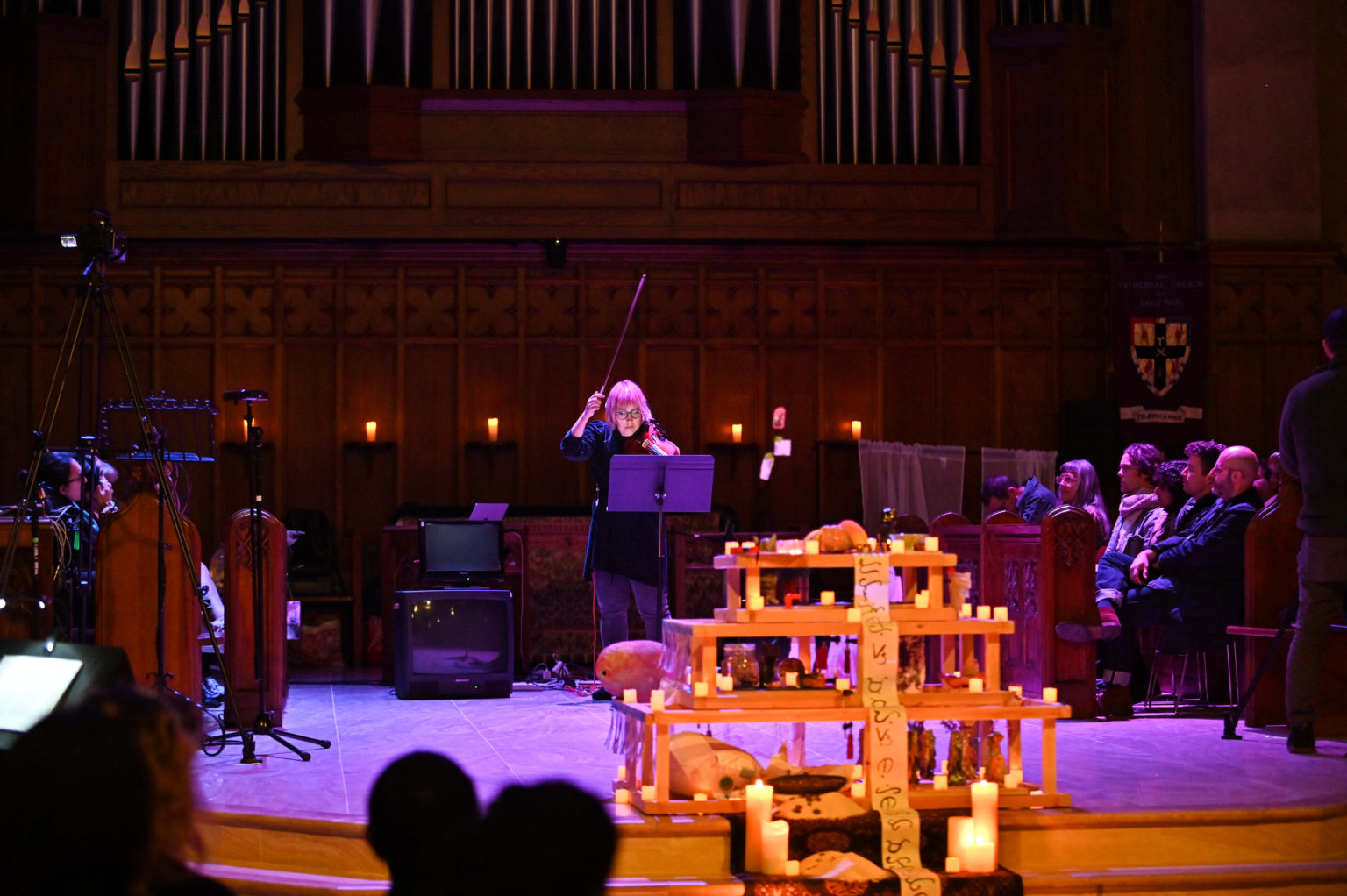‘Working Title’–The Avant-garde Art and Performance Festival As Answered Prayer
Working Title, Project [BLANK]’s adventurous three-day festival of contemporary art installations, performance art, and avant-garde music staged its welcome return to St. Paul’s Cathedral in San Diego’s Bankers Hill. From Thursday through Saturday last week, an eclectic, surprisingly younger crowd leisurely perused the art that filled the cathedral sanctuary and adjacent Queen’s Garden and crowded into the chancel’s choir pews to take in an array of musical offerings that radically contrasted to the hallowed Anglican chant that typically fills that space.
Yet I noted several installations and events that played on the Cathedral’s traditional spiritual function. Placed at the very edge of the chancel, Cat Gunn’s altar like sculpture honoring Filipino elders and ancestors—deftly illuminated and graced with with flickering candles—immediately drew the attention of even the most casual observer. Gunn’s mysterious Tagalog title “dalangin ko sa mga diyos na hindi kita makakalimutan,” translated as “I pray to the gods I will never forget you,” could easily serve as the festival’s votive incantation.Nick Lesley’s video icon titled “Rapture” invited the observer to contemplate the enthusiasm of individuals’ ecstatic movements in the mosh pit of a punk performance. Bathed in flickering illumination that evoked brilliant stained glass windows, the icon was placed on a pedestal and framed by a projected ogive arch.
A more spacious video projected on another high wall of the nave, “A Solstice Invocation of Medusa Consciousness,” captured an outdoor ritual held in Boston’s North End district in which three Wiccan divines ceremoniously walked a vibrant trefoil labyrinth on a sunny afternoon. The artists responsible for this work: Ash Capachione, Vin Caponigro, Maria Molten, and Laura Campagna.
The seven singers of the San Diego New Verbal Workshop gave a glowing account of Dom Cooper’s “Labyrinthine” as they ceremoniously walked the giant labyrinth painted on the floor of the Cathedral’s spacious Great Hall. Each singer sustained a single tone comfortable in their range, creating a rich, sonorous cluster chord that filled the live space with 20 minutes of choral bliss.
Mezzo-soprano Leslie Ann Leytham and contrabassist Matthew Kline gave a bravura, bold account of Sofia Gubaidulina’s “Aus den Visionen der Hildegarde von Bingen,” sending soaring, sonic arcs antiphonally as they faced one another at opposite ends of the Cathedral nave. Projecting a frightening array of colors and textures, Kline evoked the cosmic reach of the nun’s ecstatic chant, delivered with chilling power and conviction by Leytham.
A far more subtle but equally spiritually probing etude, “Weiss/Weisslich 31e” by Peter Eblinger was presented by ace percussionist Kosuke Matsuda. The composer’s detailed score instructed Matsuda how to arrange and control the speed of dripping sponges suspended above hollow glass tubes of differing lengths so their gentle, precisely pitched ringing could be picked up by microphones that allowed these tones to be amplified from the Cathedral chancel. A uniquely haunting experience, although it called to mind the ethereal timbre of the glass harmonica.
Violinist Ilana Waiuk floated gentle, disparate thematic strands that opened Akari Komura’s “Moon Greeting,” although this meditation soon expanded into intense, complex roulades that climaxed with violent pizzicato strokes. Joseph Bourdeau offered his “Prayer” as the metallic rustle of suspended objects that functioned as miniature gongs accompanied by three large video screens. The static stasis of the lines across these screens reminded me of evenings of poor reception on black and white television in its early days.
Perhaps the most welcoming aspect of this festival was its relaxed atmosphere that allowed participants to take in the installations and events at their own pace, to break for refreshments in the Cathedral courtyard, and then return to give the art a second appraisal.

Ken Herman, a classically trained pianist and organist, has covered music for the San Diego Union, the Los Angeles Times’ San Diego Edition, and for sandiego.com. He has won numerous awards, including first place for Live Performance and Opera Reviews in the 2017, the 2018, and the 2019 Excellence in Journalism Awards competition held by the San Diego Press Club. A Chicago native, he came to San Diego to pursue a graduate degree and stayed.Read more…

